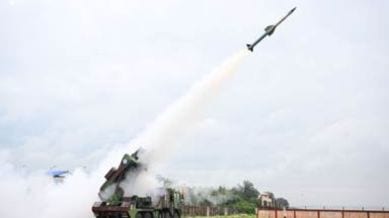Stay updated with the latest - Click here to follow us on Instagram
Exclusive: Over-the-horizon radars, energy weapons, satellites to be integrated into ‘Sudarshan Chakra’ air defence shield
The multilayered air defence shield is aimed at monitoring, detecting, identifying and destroying enemy threats directed at India.

India’s Mission Sudarshan Chakra will create a nationwide air defence shield by linking 6,000 to 7,000 radars (to track hostile targets far beyond the horizon), satellites (to keep constant watch from space), and DEWs or directed energy weapons (laser-based systems designed to destroy enemy threats). These, along with other surveillance and defence platforms, will feed into one integrated network, The Indian Express has learnt.
According to sources, the armed forces, paramilitary forces, defence PSUs, the private sector and several R&D bodies will be part of the project. Strategic locations to be covered by the system have already been identified, sources said.
monthly limit of free stories.
with an Express account.
The multilayered air defence shield is aimed at monitoring, detecting, identifying and destroying enemy threats directed at India. Currently, the country’s air defence infrastructure is largely focused on protecting critical military installations and strategic assets. Sudarshan Chakra will extend this coverage significantly to key locations and population centres across the country.
As India looks to augment its space surveillance capabilities for the defence forces, work is already underway to deploy 52 new surveillance satellites by 2030 under Phase 3 of the Space-Based Surveillance (SBS) programme. These will be linked with smaller air defence assets and radars under Sudarshan Chakra, scanning and tracking enemy aircraft, drones or missiles, and cueing weapon systems for interception.
Multiple radar systems, including Over-the-Horizon (OTH) radars capable of looking deep into enemy territory, are planned to be procured and integrated into the shield to detect and track hostile aircraft, drones and missiles, and to direct their destruction through linked weapon systems.
Indigenously developed directed energy weapons (DEWs), which use high-powered lasers to neutralise targets, will also be part of the network. Sources said the multilayered shield would be designed to counter aerial threats at both strategic and tactical levels.
Satellites, OTH radars and DEWs will be integrated with long- and medium-range missile systems, anti-drone technologies and air defence guns, creating layered protection against a wide range of threats. Most of these platforms are planned to be designed and built in India, though existing weapon systems from global manufacturers will also be folded in to form a consolidated, nationwide defence.
Prime Minister Narendra Modi had announced the launch of Mission Sudarshan Chakra on Independence Day, calling it a comprehensive, networked system to protect India and its vital installations. Defence Minister Rajnath Singh later described it as India’s “resolve for self-defence,” saying all important places would be shielded with modern, indigenously developed technology.
Chief of Defence Staff General Anil Chauhan, while describing it as India’s version of the Iron Dome or Golden Dome, said the mission would act both as shield and sword – protecting strategic and civilian sites while creating the infrastructure to detect, acquire and neutralise enemy air threats.
“Colossal amounts of data will need to be analysed in real time. Artificial intelligence, advanced computation, data analytics, big data, LLMs and quantum technologies will be essential,” he said.
The Defence Research and Development Organisation (DRDO) has also taken early steps. Last month, it successfully tested the Integrated Air Defence Weapon System (IADWS), which combined Quick Reaction Surface-to-Air Missiles or QRSAM (for intercepting hostile aircraft), Very Short Range Air Defence or VSHORADS missiles (for close-range threats) and a 5-kilowatt laser. The indigenous system, which integrates missile and laser defences, is likely to be a key component of the Sudarshan Chakra shield.